Strategic Financial Management: Analysis of Next Plc.
VerifiedAdded on 2023/01/10
|11
|3335
|52
AI Summary
This report analyzes the financial performance of Next Plc. using ratio analysis and assesses the significant developments and challenges in the retail sector.
Contribute Materials
Your contribution can guide someone’s learning journey. Share your
documents today.
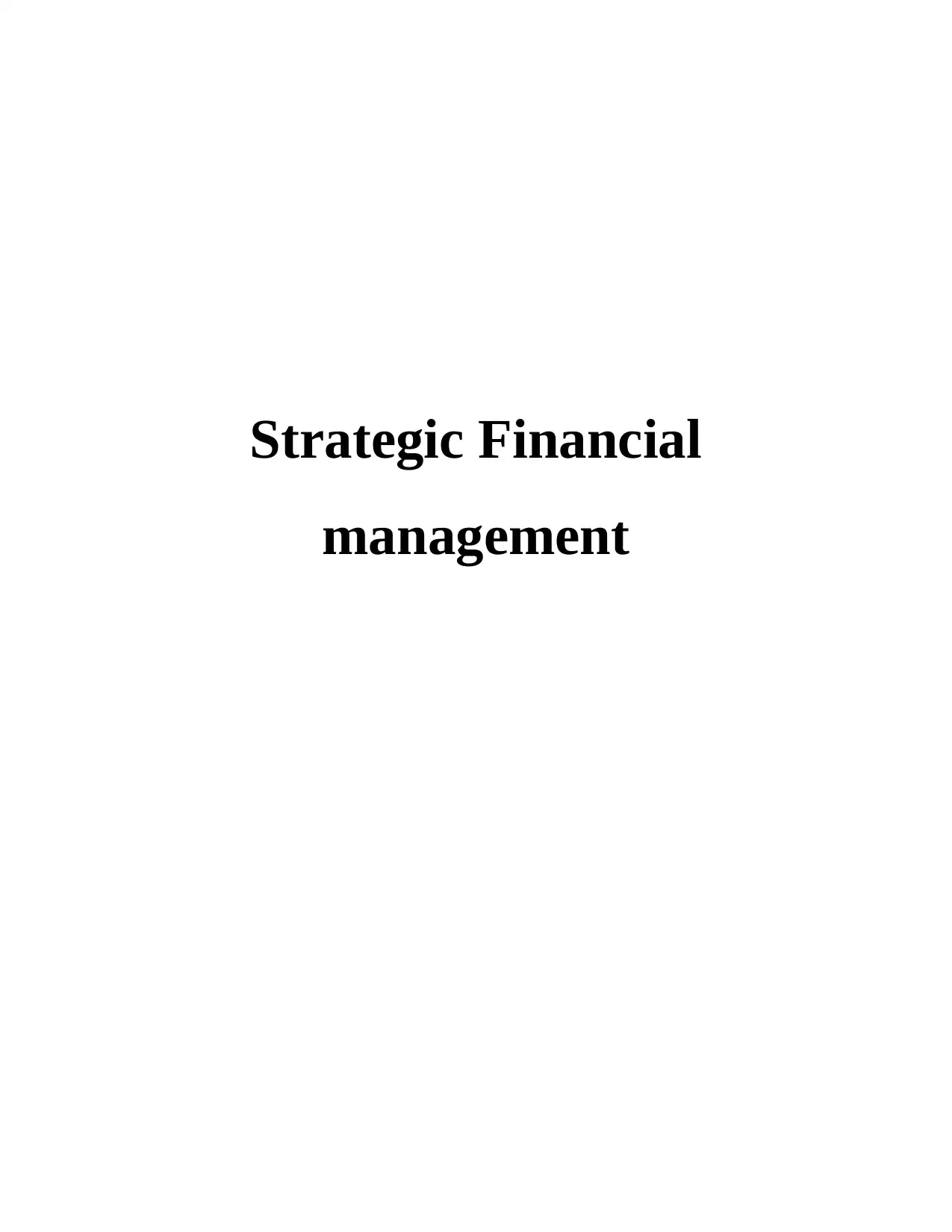
Strategic Financial
management
management
Secure Best Marks with AI Grader
Need help grading? Try our AI Grader for instant feedback on your assignments.
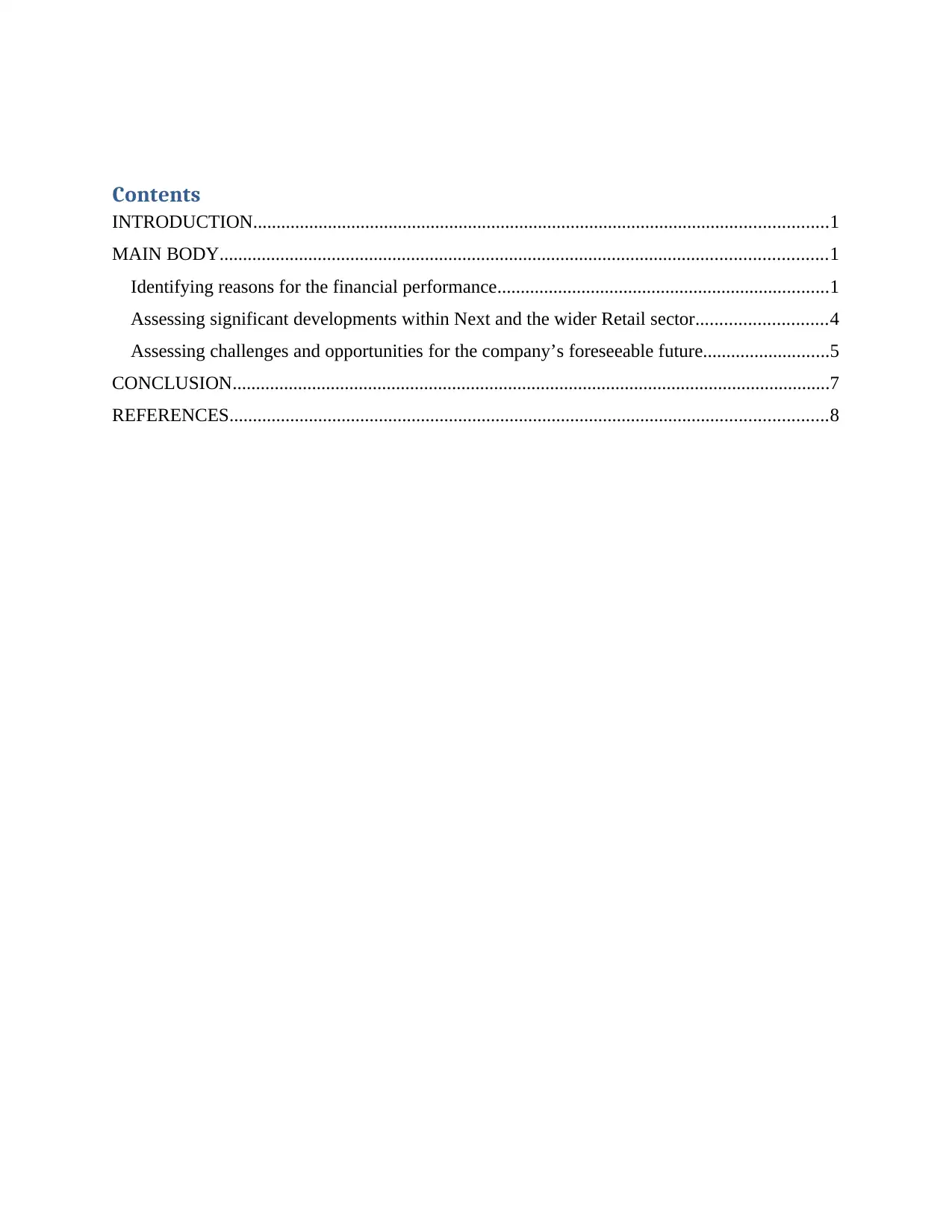
Contents
INTRODUCTION...........................................................................................................................1
MAIN BODY..................................................................................................................................1
Identifying reasons for the financial performance.......................................................................1
Assessing significant developments within Next and the wider Retail sector............................4
Assessing challenges and opportunities for the company’s foreseeable future...........................5
CONCLUSION................................................................................................................................7
REFERENCES................................................................................................................................8
INTRODUCTION...........................................................................................................................1
MAIN BODY..................................................................................................................................1
Identifying reasons for the financial performance.......................................................................1
Assessing significant developments within Next and the wider Retail sector............................4
Assessing challenges and opportunities for the company’s foreseeable future...........................5
CONCLUSION................................................................................................................................7
REFERENCES................................................................................................................................8

INTRODUCTION
Strategic financial management is the branch of study which focuses on usage of financial
information of an organisation in order to develop valid polices and strategies of the effective
operations and growth in market. The process of strategy formulation is conducted by using
various financial tools (Ahammed, 2018). The main aim of this report is to build an
understanding about tools which can be used in strategic financial planning and management by
an organisation. For this purpose, the organisation which has been selected is Next Plc. This
company is a large scale multi national retailer which has its headquarters in United Kingdom.
The operations of this company are spread across United Kingdom, Asia and Europe and this
company is listed at London stock exchange (Overview of Next Plc, 2020).
In this report, the reasons behind the financial position of Next Plc. will be analysed by
using the financial tool of ratio analysis. Furthermore, in this report developments within this
company will be assessed along with the opportunities and challenges that company can face in
future.
MAIN BODY
Identifying reasons for the financial performance
Financial performance of an organisation is reflected in its financial statements that include
income statement, balance sheet and cash flow statement (Fernie and Sparks, 2018). Using the
financial summary and annual reports of Next Plc., the ratio analysis of this company are
conducted for the year 2013, 2015, 2015 and 2019. The selection of these years will help in
fulfilling the aim which is to identify and assess the significant financial developments in Next
Plc. along with analysis of the reasons of these developments.
Ratio analysis is a strategic financial tool which is used to check and interpret the liquidity,
efficiency, solvency and profitability of an economic entity. The ratios will be will be used in
this analysis are net profit, gross profit, current ratio, debt equity and fixed asset turnover ratio.
Net profit – The first ratio which is selected for analysis is net profit ratio. This ratio helps
in ascertaining the profit making ability of an organisation. Considering the summary statistics of
Next Plc., the net profit before taxation has been considered instead of using net profit after
taxation.
1
Strategic financial management is the branch of study which focuses on usage of financial
information of an organisation in order to develop valid polices and strategies of the effective
operations and growth in market. The process of strategy formulation is conducted by using
various financial tools (Ahammed, 2018). The main aim of this report is to build an
understanding about tools which can be used in strategic financial planning and management by
an organisation. For this purpose, the organisation which has been selected is Next Plc. This
company is a large scale multi national retailer which has its headquarters in United Kingdom.
The operations of this company are spread across United Kingdom, Asia and Europe and this
company is listed at London stock exchange (Overview of Next Plc, 2020).
In this report, the reasons behind the financial position of Next Plc. will be analysed by
using the financial tool of ratio analysis. Furthermore, in this report developments within this
company will be assessed along with the opportunities and challenges that company can face in
future.
MAIN BODY
Identifying reasons for the financial performance
Financial performance of an organisation is reflected in its financial statements that include
income statement, balance sheet and cash flow statement (Fernie and Sparks, 2018). Using the
financial summary and annual reports of Next Plc., the ratio analysis of this company are
conducted for the year 2013, 2015, 2015 and 2019. The selection of these years will help in
fulfilling the aim which is to identify and assess the significant financial developments in Next
Plc. along with analysis of the reasons of these developments.
Ratio analysis is a strategic financial tool which is used to check and interpret the liquidity,
efficiency, solvency and profitability of an economic entity. The ratios will be will be used in
this analysis are net profit, gross profit, current ratio, debt equity and fixed asset turnover ratio.
Net profit – The first ratio which is selected for analysis is net profit ratio. This ratio helps
in ascertaining the profit making ability of an organisation. Considering the summary statistics of
Next Plc., the net profit before taxation has been considered instead of using net profit after
taxation.
1
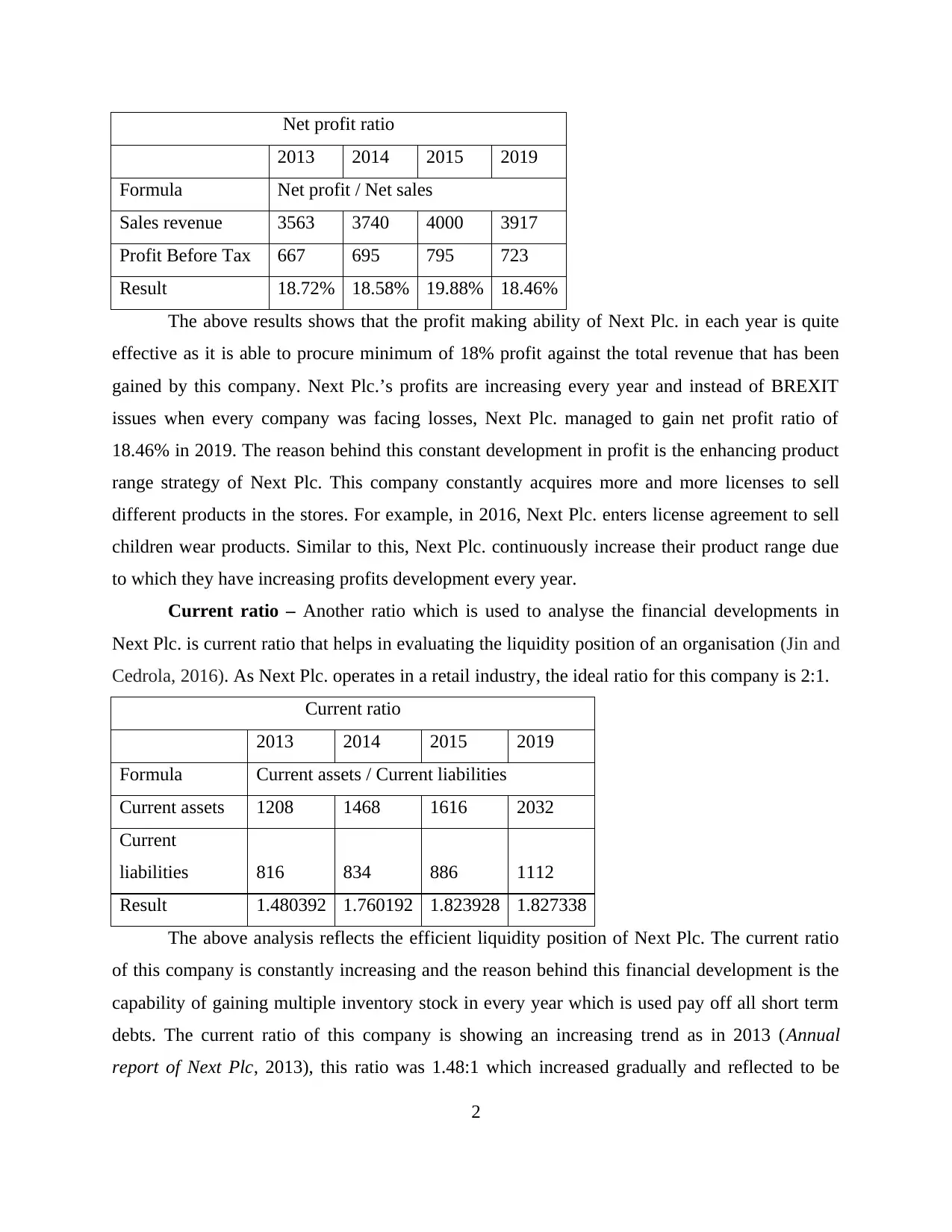
Net profit ratio
2013 2014 2015 2019
Formula Net profit / Net sales
Sales revenue 3563 3740 4000 3917
Profit Before Tax 667 695 795 723
Result 18.72% 18.58% 19.88% 18.46%
The above results shows that the profit making ability of Next Plc. in each year is quite
effective as it is able to procure minimum of 18% profit against the total revenue that has been
gained by this company. Next Plc.’s profits are increasing every year and instead of BREXIT
issues when every company was facing losses, Next Plc. managed to gain net profit ratio of
18.46% in 2019. The reason behind this constant development in profit is the enhancing product
range strategy of Next Plc. This company constantly acquires more and more licenses to sell
different products in the stores. For example, in 2016, Next Plc. enters license agreement to sell
children wear products. Similar to this, Next Plc. continuously increase their product range due
to which they have increasing profits development every year.
Current ratio – Another ratio which is used to analyse the financial developments in
Next Plc. is current ratio that helps in evaluating the liquidity position of an organisation (Jin and
Cedrola, 2016). As Next Plc. operates in a retail industry, the ideal ratio for this company is 2:1.
Current ratio
2013 2014 2015 2019
Formula Current assets / Current liabilities
Current assets 1208 1468 1616 2032
Current
liabilities 816 834 886 1112
Result 1.480392 1.760192 1.823928 1.827338
The above analysis reflects the efficient liquidity position of Next Plc. The current ratio
of this company is constantly increasing and the reason behind this financial development is the
capability of gaining multiple inventory stock in every year which is used pay off all short term
debts. The current ratio of this company is showing an increasing trend as in 2013 (Annual
report of Next Plc, 2013), this ratio was 1.48:1 which increased gradually and reflected to be
2
2013 2014 2015 2019
Formula Net profit / Net sales
Sales revenue 3563 3740 4000 3917
Profit Before Tax 667 695 795 723
Result 18.72% 18.58% 19.88% 18.46%
The above results shows that the profit making ability of Next Plc. in each year is quite
effective as it is able to procure minimum of 18% profit against the total revenue that has been
gained by this company. Next Plc.’s profits are increasing every year and instead of BREXIT
issues when every company was facing losses, Next Plc. managed to gain net profit ratio of
18.46% in 2019. The reason behind this constant development in profit is the enhancing product
range strategy of Next Plc. This company constantly acquires more and more licenses to sell
different products in the stores. For example, in 2016, Next Plc. enters license agreement to sell
children wear products. Similar to this, Next Plc. continuously increase their product range due
to which they have increasing profits development every year.
Current ratio – Another ratio which is used to analyse the financial developments in
Next Plc. is current ratio that helps in evaluating the liquidity position of an organisation (Jin and
Cedrola, 2016). As Next Plc. operates in a retail industry, the ideal ratio for this company is 2:1.
Current ratio
2013 2014 2015 2019
Formula Current assets / Current liabilities
Current assets 1208 1468 1616 2032
Current
liabilities 816 834 886 1112
Result 1.480392 1.760192 1.823928 1.827338
The above analysis reflects the efficient liquidity position of Next Plc. The current ratio
of this company is constantly increasing and the reason behind this financial development is the
capability of gaining multiple inventory stock in every year which is used pay off all short term
debts. The current ratio of this company is showing an increasing trend as in 2013 (Annual
report of Next Plc, 2013), this ratio was 1.48:1 which increased gradually and reflected to be
2
Secure Best Marks with AI Grader
Need help grading? Try our AI Grader for instant feedback on your assignments.
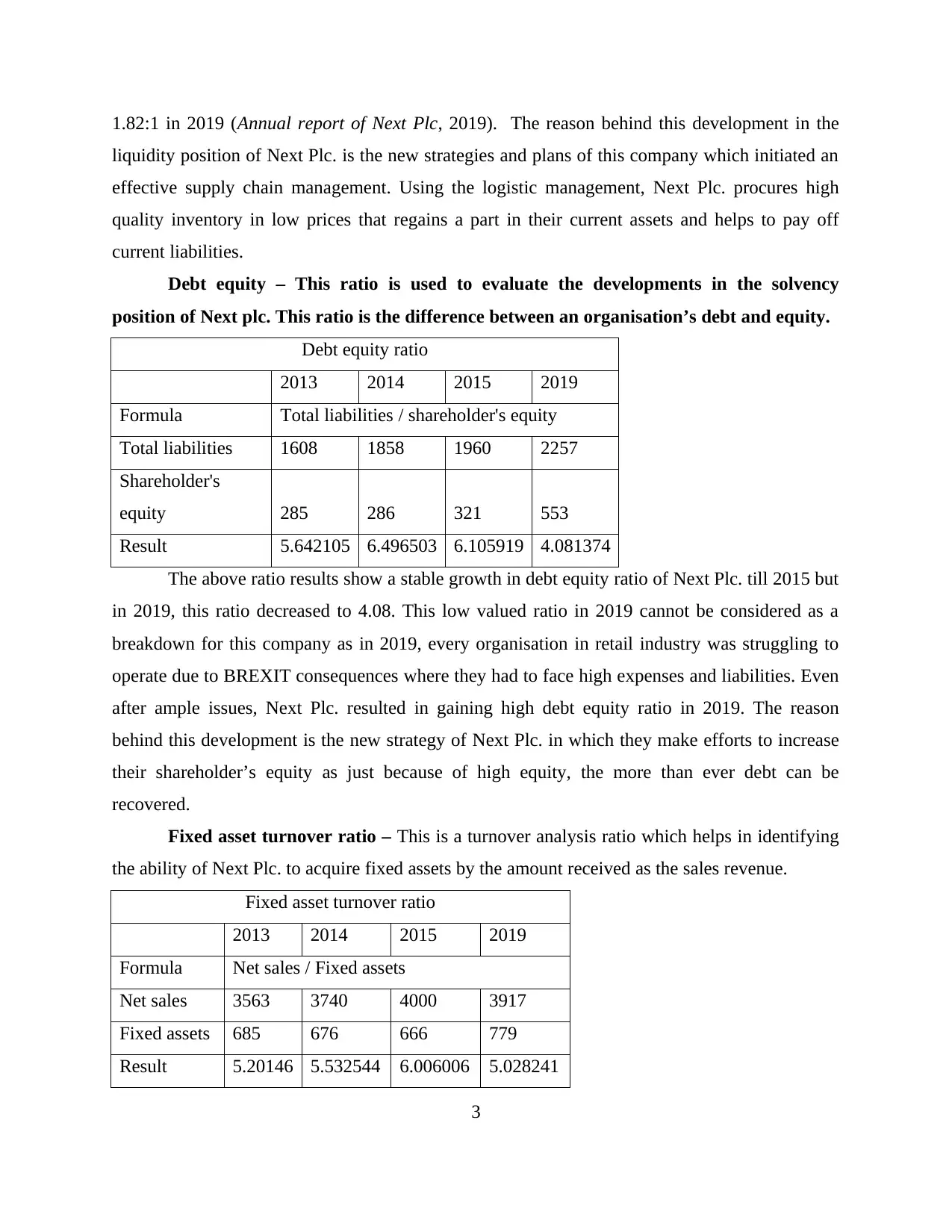
1.82:1 in 2019 (Annual report of Next Plc, 2019). The reason behind this development in the
liquidity position of Next Plc. is the new strategies and plans of this company which initiated an
effective supply chain management. Using the logistic management, Next Plc. procures high
quality inventory in low prices that regains a part in their current assets and helps to pay off
current liabilities.
Debt equity – This ratio is used to evaluate the developments in the solvency
position of Next plc. This ratio is the difference between an organisation’s debt and equity.
Debt equity ratio
2013 2014 2015 2019
Formula Total liabilities / shareholder's equity
Total liabilities 1608 1858 1960 2257
Shareholder's
equity 285 286 321 553
Result 5.642105 6.496503 6.105919 4.081374
The above ratio results show a stable growth in debt equity ratio of Next Plc. till 2015 but
in 2019, this ratio decreased to 4.08. This low valued ratio in 2019 cannot be considered as a
breakdown for this company as in 2019, every organisation in retail industry was struggling to
operate due to BREXIT consequences where they had to face high expenses and liabilities. Even
after ample issues, Next Plc. resulted in gaining high debt equity ratio in 2019. The reason
behind this development is the new strategy of Next Plc. in which they make efforts to increase
their shareholder’s equity as just because of high equity, the more than ever debt can be
recovered.
Fixed asset turnover ratio – This is a turnover analysis ratio which helps in identifying
the ability of Next Plc. to acquire fixed assets by the amount received as the sales revenue.
Fixed asset turnover ratio
2013 2014 2015 2019
Formula Net sales / Fixed assets
Net sales 3563 3740 4000 3917
Fixed assets 685 676 666 779
Result 5.20146 5.532544 6.006006 5.028241
3
liquidity position of Next Plc. is the new strategies and plans of this company which initiated an
effective supply chain management. Using the logistic management, Next Plc. procures high
quality inventory in low prices that regains a part in their current assets and helps to pay off
current liabilities.
Debt equity – This ratio is used to evaluate the developments in the solvency
position of Next plc. This ratio is the difference between an organisation’s debt and equity.
Debt equity ratio
2013 2014 2015 2019
Formula Total liabilities / shareholder's equity
Total liabilities 1608 1858 1960 2257
Shareholder's
equity 285 286 321 553
Result 5.642105 6.496503 6.105919 4.081374
The above ratio results show a stable growth in debt equity ratio of Next Plc. till 2015 but
in 2019, this ratio decreased to 4.08. This low valued ratio in 2019 cannot be considered as a
breakdown for this company as in 2019, every organisation in retail industry was struggling to
operate due to BREXIT consequences where they had to face high expenses and liabilities. Even
after ample issues, Next Plc. resulted in gaining high debt equity ratio in 2019. The reason
behind this development is the new strategy of Next Plc. in which they make efforts to increase
their shareholder’s equity as just because of high equity, the more than ever debt can be
recovered.
Fixed asset turnover ratio – This is a turnover analysis ratio which helps in identifying
the ability of Next Plc. to acquire fixed assets by the amount received as the sales revenue.
Fixed asset turnover ratio
2013 2014 2015 2019
Formula Net sales / Fixed assets
Net sales 3563 3740 4000 3917
Fixed assets 685 676 666 779
Result 5.20146 5.532544 6.006006 5.028241
3
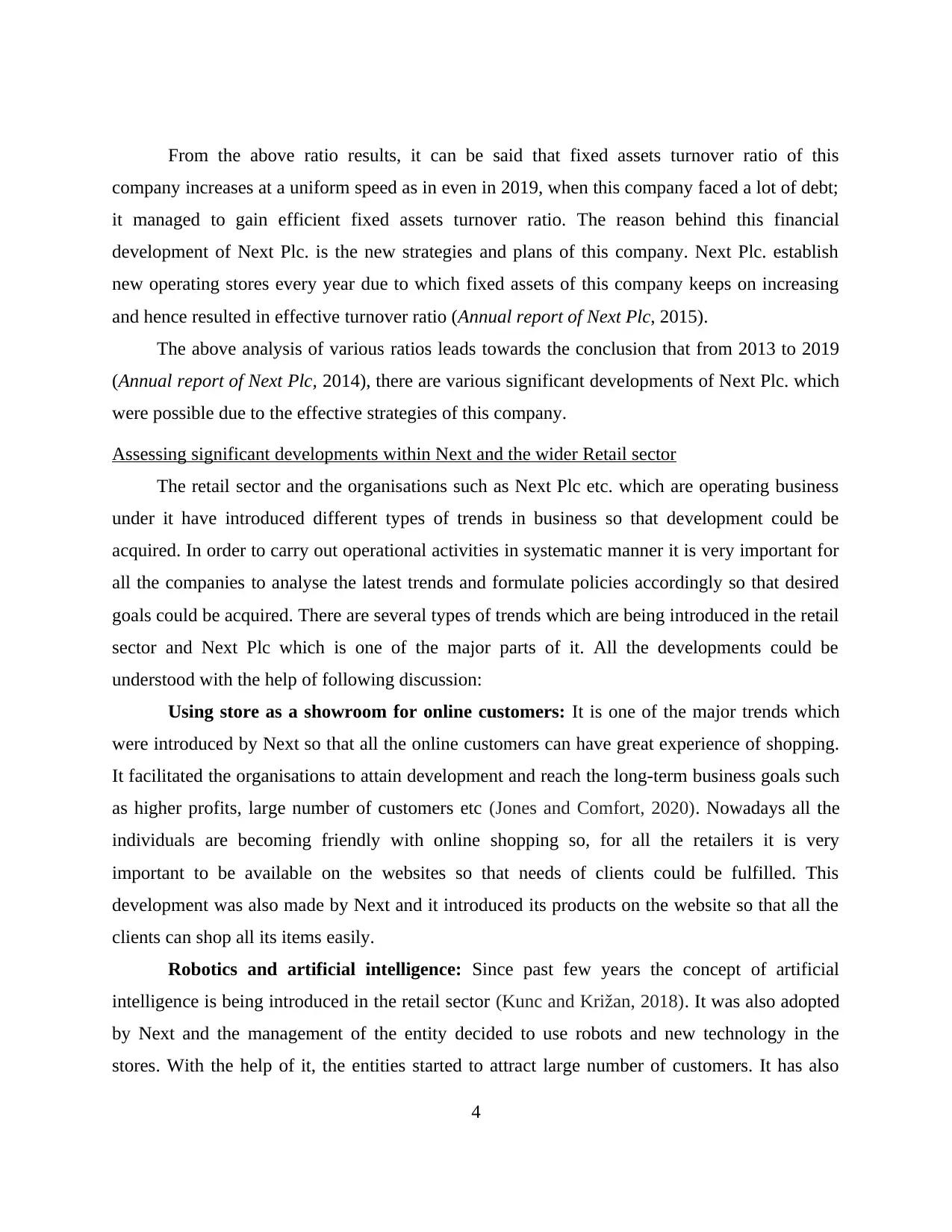
From the above ratio results, it can be said that fixed assets turnover ratio of this
company increases at a uniform speed as in even in 2019, when this company faced a lot of debt;
it managed to gain efficient fixed assets turnover ratio. The reason behind this financial
development of Next Plc. is the new strategies and plans of this company. Next Plc. establish
new operating stores every year due to which fixed assets of this company keeps on increasing
and hence resulted in effective turnover ratio (Annual report of Next Plc, 2015).
The above analysis of various ratios leads towards the conclusion that from 2013 to 2019
(Annual report of Next Plc, 2014), there are various significant developments of Next Plc. which
were possible due to the effective strategies of this company.
Assessing significant developments within Next and the wider Retail sector
The retail sector and the organisations such as Next Plc etc. which are operating business
under it have introduced different types of trends in business so that development could be
acquired. In order to carry out operational activities in systematic manner it is very important for
all the companies to analyse the latest trends and formulate policies accordingly so that desired
goals could be acquired. There are several types of trends which are being introduced in the retail
sector and Next Plc which is one of the major parts of it. All the developments could be
understood with the help of following discussion:
Using store as a showroom for online customers: It is one of the major trends which
were introduced by Next so that all the online customers can have great experience of shopping.
It facilitated the organisations to attain development and reach the long-term business goals such
as higher profits, large number of customers etc (Jones and Comfort, 2020). Nowadays all the
individuals are becoming friendly with online shopping so, for all the retailers it is very
important to be available on the websites so that needs of clients could be fulfilled. This
development was also made by Next and it introduced its products on the website so that all the
clients can shop all its items easily.
Robotics and artificial intelligence: Since past few years the concept of artificial
intelligence is being introduced in the retail sector (Kunc and Križan, 2018). It was also adopted
by Next and the management of the entity decided to use robots and new technology in the
stores. With the help of it, the entities started to attract large number of customers. It has also
4
company increases at a uniform speed as in even in 2019, when this company faced a lot of debt;
it managed to gain efficient fixed assets turnover ratio. The reason behind this financial
development of Next Plc. is the new strategies and plans of this company. Next Plc. establish
new operating stores every year due to which fixed assets of this company keeps on increasing
and hence resulted in effective turnover ratio (Annual report of Next Plc, 2015).
The above analysis of various ratios leads towards the conclusion that from 2013 to 2019
(Annual report of Next Plc, 2014), there are various significant developments of Next Plc. which
were possible due to the effective strategies of this company.
Assessing significant developments within Next and the wider Retail sector
The retail sector and the organisations such as Next Plc etc. which are operating business
under it have introduced different types of trends in business so that development could be
acquired. In order to carry out operational activities in systematic manner it is very important for
all the companies to analyse the latest trends and formulate policies accordingly so that desired
goals could be acquired. There are several types of trends which are being introduced in the retail
sector and Next Plc which is one of the major parts of it. All the developments could be
understood with the help of following discussion:
Using store as a showroom for online customers: It is one of the major trends which
were introduced by Next so that all the online customers can have great experience of shopping.
It facilitated the organisations to attain development and reach the long-term business goals such
as higher profits, large number of customers etc (Jones and Comfort, 2020). Nowadays all the
individuals are becoming friendly with online shopping so, for all the retailers it is very
important to be available on the websites so that needs of clients could be fulfilled. This
development was also made by Next and it introduced its products on the website so that all the
clients can shop all its items easily.
Robotics and artificial intelligence: Since past few years the concept of artificial
intelligence is being introduced in the retail sector (Kunc and Križan, 2018). It was also adopted
by Next and the management of the entity decided to use robots and new technology in the
stores. With the help of it, the entities started to attract large number of customers. It has also
4

facilitated to reduce the work load of staff members and the customers can also get quick
answers for all their queries. It is one of the major developments in the retail sector which has
facilitated the organisation to grow and capture a large market share.
Customisation of products: It is also a trend which was introduced in retail sector after
2013. Customisation in shopping means personal touch to the items that are bought by
customers. With the development of retail industry, the preference of customers for the
customised products is increased and to sustain in the market it is very important for companies
such as Next it is very important to adopt the trends and carry out operations successfully. The
entity also started to follow this trend and provided facility of customisation to the clients so that
they can get all the items that they are willing to buy according to their choice. With the help of
it, the organisation developed its business and attained growth for future as it has facilitated to
attract large number of customers (Valério, 2017).
After sales services: It is also a major trend which was focused by Next Plc so that it can
enhance the satisfaction level of customers. Main purpose of the entity to make sure that all the
clients get satisfied with its services and the quality of products that are sold by it. In order to
reach the objective, the entity started to pay attention towards after sales services. The staff
members of the company take timely feedback from customers on the items that are sold to
them. With the help of it, the managers try to meet the requirements of business. It has also
facilitated Next t develop its business and attain growth for upcoming period. Since 2013 the
entity is highly focused with the after sales services so that all the customers could be retained by
it for long run in future (Mashiah, 2019).
Assessing challenges and opportunities for the company’s foreseeable future
Next Plc. is one of the largest retail entities in UK which are operating business at global
level. The company is carrying out all its operations successfully and attain growth on
continuous basis. In order to be more successful, it is very important for the enterprise to make
sure that it pays attention towards challenges and opportunities that are available for it in the
market. By identifying them, it will be able to formulate strategic decisions to deal with
challenges and adopt the opportunities to achieve growth. By analysing the financial
performance as well as trends in retail industry various challenges and opportunities are
identified for Next which could be understood with the help of following discussion:
5
answers for all their queries. It is one of the major developments in the retail sector which has
facilitated the organisation to grow and capture a large market share.
Customisation of products: It is also a trend which was introduced in retail sector after
2013. Customisation in shopping means personal touch to the items that are bought by
customers. With the development of retail industry, the preference of customers for the
customised products is increased and to sustain in the market it is very important for companies
such as Next it is very important to adopt the trends and carry out operations successfully. The
entity also started to follow this trend and provided facility of customisation to the clients so that
they can get all the items that they are willing to buy according to their choice. With the help of
it, the organisation developed its business and attained growth for future as it has facilitated to
attract large number of customers (Valério, 2017).
After sales services: It is also a major trend which was focused by Next Plc so that it can
enhance the satisfaction level of customers. Main purpose of the entity to make sure that all the
clients get satisfied with its services and the quality of products that are sold by it. In order to
reach the objective, the entity started to pay attention towards after sales services. The staff
members of the company take timely feedback from customers on the items that are sold to
them. With the help of it, the managers try to meet the requirements of business. It has also
facilitated Next t develop its business and attain growth for upcoming period. Since 2013 the
entity is highly focused with the after sales services so that all the customers could be retained by
it for long run in future (Mashiah, 2019).
Assessing challenges and opportunities for the company’s foreseeable future
Next Plc. is one of the largest retail entities in UK which are operating business at global
level. The company is carrying out all its operations successfully and attain growth on
continuous basis. In order to be more successful, it is very important for the enterprise to make
sure that it pays attention towards challenges and opportunities that are available for it in the
market. By identifying them, it will be able to formulate strategic decisions to deal with
challenges and adopt the opportunities to achieve growth. By analysing the financial
performance as well as trends in retail industry various challenges and opportunities are
identified for Next which could be understood with the help of following discussion:
5
Paraphrase This Document
Need a fresh take? Get an instant paraphrase of this document with our AI Paraphraser
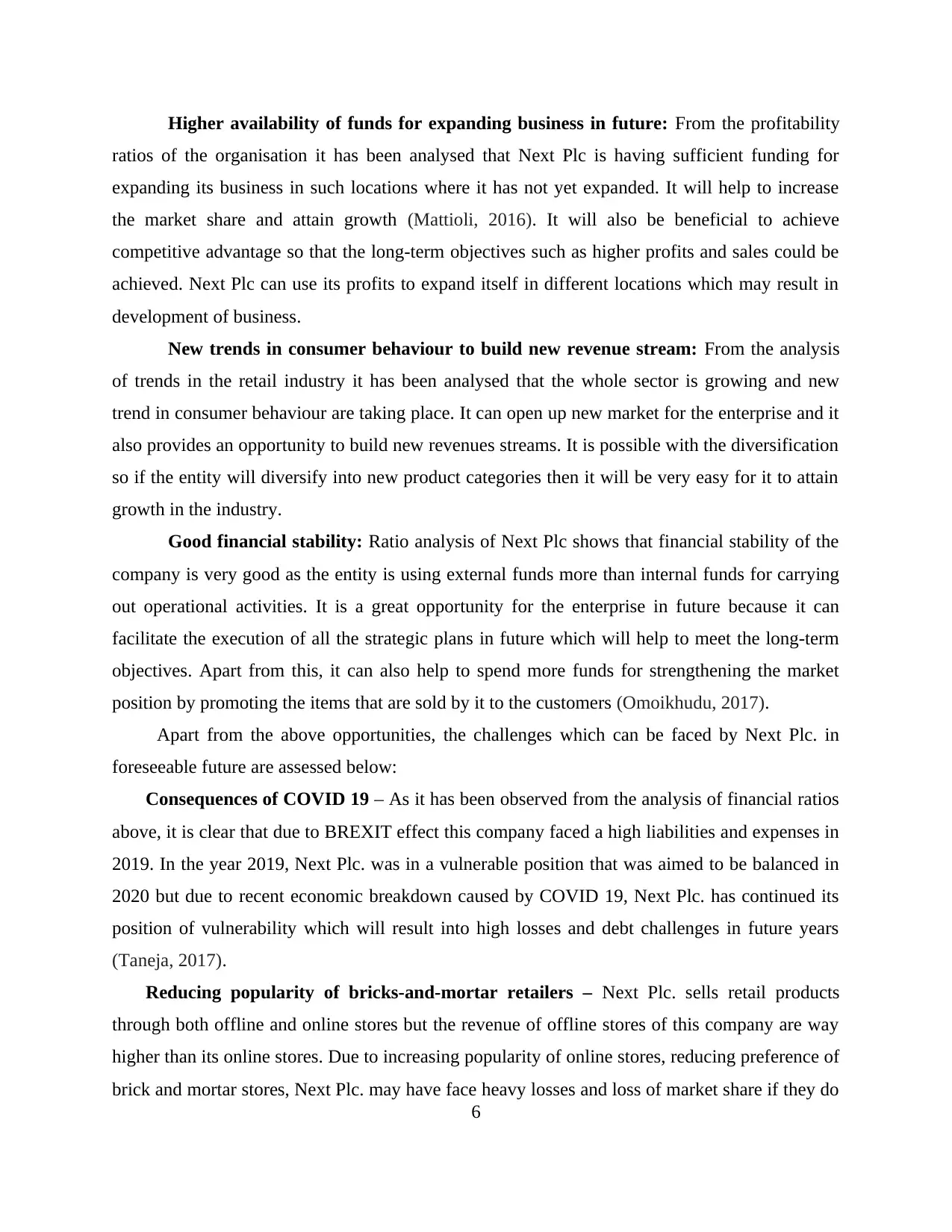
Higher availability of funds for expanding business in future: From the profitability
ratios of the organisation it has been analysed that Next Plc is having sufficient funding for
expanding its business in such locations where it has not yet expanded. It will help to increase
the market share and attain growth (Mattioli, 2016). It will also be beneficial to achieve
competitive advantage so that the long-term objectives such as higher profits and sales could be
achieved. Next Plc can use its profits to expand itself in different locations which may result in
development of business.
New trends in consumer behaviour to build new revenue stream: From the analysis
of trends in the retail industry it has been analysed that the whole sector is growing and new
trend in consumer behaviour are taking place. It can open up new market for the enterprise and it
also provides an opportunity to build new revenues streams. It is possible with the diversification
so if the entity will diversify into new product categories then it will be very easy for it to attain
growth in the industry.
Good financial stability: Ratio analysis of Next Plc shows that financial stability of the
company is very good as the entity is using external funds more than internal funds for carrying
out operational activities. It is a great opportunity for the enterprise in future because it can
facilitate the execution of all the strategic plans in future which will help to meet the long-term
objectives. Apart from this, it can also help to spend more funds for strengthening the market
position by promoting the items that are sold by it to the customers (Omoikhudu, 2017).
Apart from the above opportunities, the challenges which can be faced by Next Plc. in
foreseeable future are assessed below:
Consequences of COVID 19 – As it has been observed from the analysis of financial ratios
above, it is clear that due to BREXIT effect this company faced a high liabilities and expenses in
2019. In the year 2019, Next Plc. was in a vulnerable position that was aimed to be balanced in
2020 but due to recent economic breakdown caused by COVID 19, Next Plc. has continued its
position of vulnerability which will result into high losses and debt challenges in future years
(Taneja, 2017).
Reducing popularity of bricks-and-mortar retailers – Next Plc. sells retail products
through both offline and online stores but the revenue of offline stores of this company are way
higher than its online stores. Due to increasing popularity of online stores, reducing preference of
brick and mortar stores, Next Plc. may have face heavy losses and loss of market share if they do
6
ratios of the organisation it has been analysed that Next Plc is having sufficient funding for
expanding its business in such locations where it has not yet expanded. It will help to increase
the market share and attain growth (Mattioli, 2016). It will also be beneficial to achieve
competitive advantage so that the long-term objectives such as higher profits and sales could be
achieved. Next Plc can use its profits to expand itself in different locations which may result in
development of business.
New trends in consumer behaviour to build new revenue stream: From the analysis
of trends in the retail industry it has been analysed that the whole sector is growing and new
trend in consumer behaviour are taking place. It can open up new market for the enterprise and it
also provides an opportunity to build new revenues streams. It is possible with the diversification
so if the entity will diversify into new product categories then it will be very easy for it to attain
growth in the industry.
Good financial stability: Ratio analysis of Next Plc shows that financial stability of the
company is very good as the entity is using external funds more than internal funds for carrying
out operational activities. It is a great opportunity for the enterprise in future because it can
facilitate the execution of all the strategic plans in future which will help to meet the long-term
objectives. Apart from this, it can also help to spend more funds for strengthening the market
position by promoting the items that are sold by it to the customers (Omoikhudu, 2017).
Apart from the above opportunities, the challenges which can be faced by Next Plc. in
foreseeable future are assessed below:
Consequences of COVID 19 – As it has been observed from the analysis of financial ratios
above, it is clear that due to BREXIT effect this company faced a high liabilities and expenses in
2019. In the year 2019, Next Plc. was in a vulnerable position that was aimed to be balanced in
2020 but due to recent economic breakdown caused by COVID 19, Next Plc. has continued its
position of vulnerability which will result into high losses and debt challenges in future years
(Taneja, 2017).
Reducing popularity of bricks-and-mortar retailers – Next Plc. sells retail products
through both offline and online stores but the revenue of offline stores of this company are way
higher than its online stores. Due to increasing popularity of online stores, reducing preference of
brick and mortar stores, Next Plc. may have face heavy losses and loss of market share if they do
6
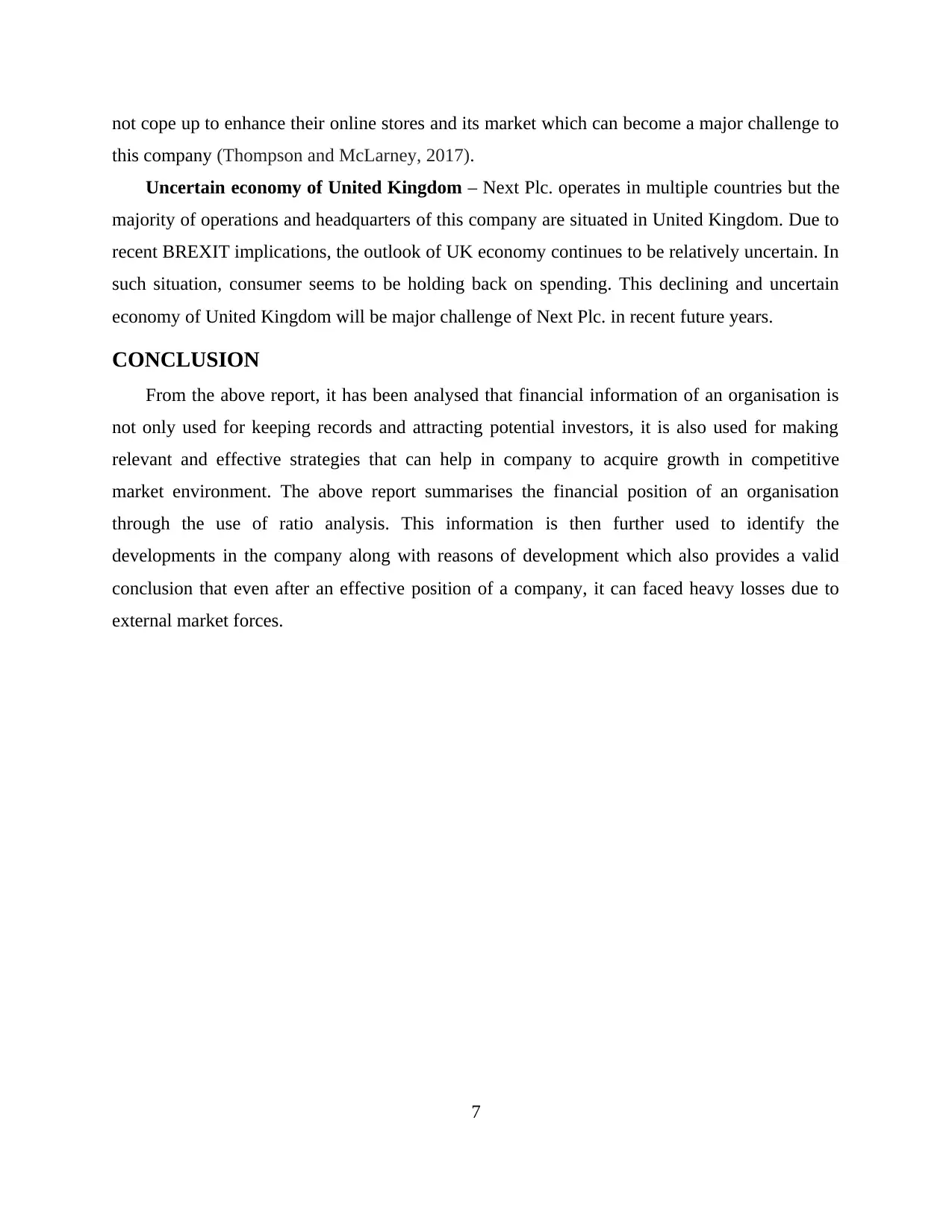
not cope up to enhance their online stores and its market which can become a major challenge to
this company (Thompson and McLarney, 2017).
Uncertain economy of United Kingdom – Next Plc. operates in multiple countries but the
majority of operations and headquarters of this company are situated in United Kingdom. Due to
recent BREXIT implications, the outlook of UK economy continues to be relatively uncertain. In
such situation, consumer seems to be holding back on spending. This declining and uncertain
economy of United Kingdom will be major challenge of Next Plc. in recent future years.
CONCLUSION
From the above report, it has been analysed that financial information of an organisation is
not only used for keeping records and attracting potential investors, it is also used for making
relevant and effective strategies that can help in company to acquire growth in competitive
market environment. The above report summarises the financial position of an organisation
through the use of ratio analysis. This information is then further used to identify the
developments in the company along with reasons of development which also provides a valid
conclusion that even after an effective position of a company, it can faced heavy losses due to
external market forces.
7
this company (Thompson and McLarney, 2017).
Uncertain economy of United Kingdom – Next Plc. operates in multiple countries but the
majority of operations and headquarters of this company are situated in United Kingdom. Due to
recent BREXIT implications, the outlook of UK economy continues to be relatively uncertain. In
such situation, consumer seems to be holding back on spending. This declining and uncertain
economy of United Kingdom will be major challenge of Next Plc. in recent future years.
CONCLUSION
From the above report, it has been analysed that financial information of an organisation is
not only used for keeping records and attracting potential investors, it is also used for making
relevant and effective strategies that can help in company to acquire growth in competitive
market environment. The above report summarises the financial position of an organisation
through the use of ratio analysis. This information is then further used to identify the
developments in the company along with reasons of development which also provides a valid
conclusion that even after an effective position of a company, it can faced heavy losses due to
external market forces.
7
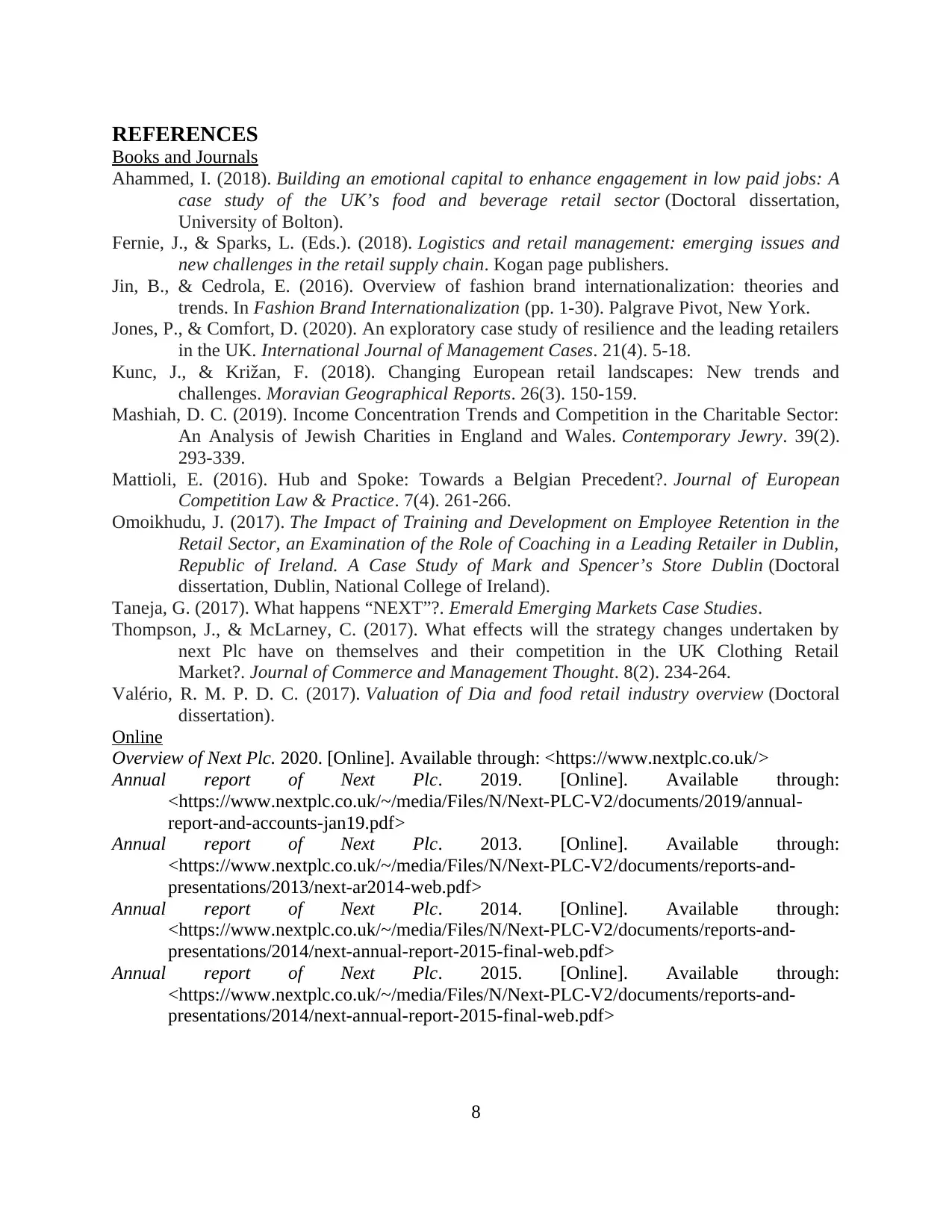
REFERENCES
Books and Journals
Ahammed, I. (2018). Building an emotional capital to enhance engagement in low paid jobs: A
case study of the UK’s food and beverage retail sector (Doctoral dissertation,
University of Bolton).
Fernie, J., & Sparks, L. (Eds.). (2018). Logistics and retail management: emerging issues and
new challenges in the retail supply chain. Kogan page publishers.
Jin, B., & Cedrola, E. (2016). Overview of fashion brand internationalization: theories and
trends. In Fashion Brand Internationalization (pp. 1-30). Palgrave Pivot, New York.
Jones, P., & Comfort, D. (2020). An exploratory case study of resilience and the leading retailers
in the UK. International Journal of Management Cases. 21(4). 5-18.
Kunc, J., & Križan, F. (2018). Changing European retail landscapes: New trends and
challenges. Moravian Geographical Reports. 26(3). 150-159.
Mashiah, D. C. (2019). Income Concentration Trends and Competition in the Charitable Sector:
An Analysis of Jewish Charities in England and Wales. Contemporary Jewry. 39(2).
293-339.
Mattioli, E. (2016). Hub and Spoke: Towards a Belgian Precedent?. Journal of European
Competition Law & Practice. 7(4). 261-266.
Omoikhudu, J. (2017). The Impact of Training and Development on Employee Retention in the
Retail Sector, an Examination of the Role of Coaching in a Leading Retailer in Dublin,
Republic of Ireland. A Case Study of Mark and Spencer’s Store Dublin (Doctoral
dissertation, Dublin, National College of Ireland).
Taneja, G. (2017). What happens “NEXT”?. Emerald Emerging Markets Case Studies.
Thompson, J., & McLarney, C. (2017). What effects will the strategy changes undertaken by
next Plc have on themselves and their competition in the UK Clothing Retail
Market?. Journal of Commerce and Management Thought. 8(2). 234-264.
Valério, R. M. P. D. C. (2017). Valuation of Dia and food retail industry overview (Doctoral
dissertation).
Online
Overview of Next Plc. 2020. [Online]. Available through: <https://www.nextplc.co.uk/>
Annual report of Next Plc. 2019. [Online]. Available through:
<https://www.nextplc.co.uk/~/media/Files/N/Next-PLC-V2/documents/2019/annual-
report-and-accounts-jan19.pdf>
Annual report of Next Plc. 2013. [Online]. Available through:
<https://www.nextplc.co.uk/~/media/Files/N/Next-PLC-V2/documents/reports-and-
presentations/2013/next-ar2014-web.pdf>
Annual report of Next Plc. 2014. [Online]. Available through:
<https://www.nextplc.co.uk/~/media/Files/N/Next-PLC-V2/documents/reports-and-
presentations/2014/next-annual-report-2015-final-web.pdf>
Annual report of Next Plc. 2015. [Online]. Available through:
<https://www.nextplc.co.uk/~/media/Files/N/Next-PLC-V2/documents/reports-and-
presentations/2014/next-annual-report-2015-final-web.pdf>
8
Books and Journals
Ahammed, I. (2018). Building an emotional capital to enhance engagement in low paid jobs: A
case study of the UK’s food and beverage retail sector (Doctoral dissertation,
University of Bolton).
Fernie, J., & Sparks, L. (Eds.). (2018). Logistics and retail management: emerging issues and
new challenges in the retail supply chain. Kogan page publishers.
Jin, B., & Cedrola, E. (2016). Overview of fashion brand internationalization: theories and
trends. In Fashion Brand Internationalization (pp. 1-30). Palgrave Pivot, New York.
Jones, P., & Comfort, D. (2020). An exploratory case study of resilience and the leading retailers
in the UK. International Journal of Management Cases. 21(4). 5-18.
Kunc, J., & Križan, F. (2018). Changing European retail landscapes: New trends and
challenges. Moravian Geographical Reports. 26(3). 150-159.
Mashiah, D. C. (2019). Income Concentration Trends and Competition in the Charitable Sector:
An Analysis of Jewish Charities in England and Wales. Contemporary Jewry. 39(2).
293-339.
Mattioli, E. (2016). Hub and Spoke: Towards a Belgian Precedent?. Journal of European
Competition Law & Practice. 7(4). 261-266.
Omoikhudu, J. (2017). The Impact of Training and Development on Employee Retention in the
Retail Sector, an Examination of the Role of Coaching in a Leading Retailer in Dublin,
Republic of Ireland. A Case Study of Mark and Spencer’s Store Dublin (Doctoral
dissertation, Dublin, National College of Ireland).
Taneja, G. (2017). What happens “NEXT”?. Emerald Emerging Markets Case Studies.
Thompson, J., & McLarney, C. (2017). What effects will the strategy changes undertaken by
next Plc have on themselves and their competition in the UK Clothing Retail
Market?. Journal of Commerce and Management Thought. 8(2). 234-264.
Valério, R. M. P. D. C. (2017). Valuation of Dia and food retail industry overview (Doctoral
dissertation).
Online
Overview of Next Plc. 2020. [Online]. Available through: <https://www.nextplc.co.uk/>
Annual report of Next Plc. 2019. [Online]. Available through:
<https://www.nextplc.co.uk/~/media/Files/N/Next-PLC-V2/documents/2019/annual-
report-and-accounts-jan19.pdf>
Annual report of Next Plc. 2013. [Online]. Available through:
<https://www.nextplc.co.uk/~/media/Files/N/Next-PLC-V2/documents/reports-and-
presentations/2013/next-ar2014-web.pdf>
Annual report of Next Plc. 2014. [Online]. Available through:
<https://www.nextplc.co.uk/~/media/Files/N/Next-PLC-V2/documents/reports-and-
presentations/2014/next-annual-report-2015-final-web.pdf>
Annual report of Next Plc. 2015. [Online]. Available through:
<https://www.nextplc.co.uk/~/media/Files/N/Next-PLC-V2/documents/reports-and-
presentations/2014/next-annual-report-2015-final-web.pdf>
8
Secure Best Marks with AI Grader
Need help grading? Try our AI Grader for instant feedback on your assignments.

9
1 out of 11
Related Documents
Your All-in-One AI-Powered Toolkit for Academic Success.
+13062052269
info@desklib.com
Available 24*7 on WhatsApp / Email
![[object Object]](/_next/static/media/star-bottom.7253800d.svg)
Unlock your academic potential
© 2024 | Zucol Services PVT LTD | All rights reserved.





